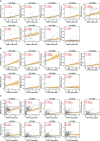An integrated analysis of bulk and single-cell sequencing data reveals that EMP1+/COL3A1+ fibroblasts contribute to the bone metastasis process in breast, prostate, and renal cancers
- PMID: 38187400
- PMCID: PMC10770257
- DOI: 10.3389/fimmu.2023.1313536
An integrated analysis of bulk and single-cell sequencing data reveals that EMP1+/COL3A1+ fibroblasts contribute to the bone metastasis process in breast, prostate, and renal cancers
Abstract
Introduction: Bone metastasis (BoM) occurs when cancer cells spread from their primary sites to a bone. Currently, the mechanism underlying this metastasis process remains unclear.
Methods: In this project, through an integrated analysis of bulk-sequencing and single-cell RNA transcriptomic data, we explored the BoM-related features in tumor microenvironments of different tumors.
Results: We first identified 34 up-regulated genes during the BoM process in breast cancer, and further explored their expression status among different components in the tumor microenvironment (TME) of BoM samples. Enriched EMP1+ fibroblasts were found in BoM samples, and a COL3A1-ADGRG1 communication between these fibroblasts and cancer cells was identified which might facilitate the BoM process. Moreover, a significant correlation between EMP1 and COL3A1 was identified in these fibroblasts, confirming the potential connection of these genes during the BoM process. Furthermore, the existence of these EMP1+/COL3A1+ fibroblasts was also verified in prostate cancer and renal cancer BoM samples, suggesting the importance of these fibroblasts from a pan-cancer perspective.
Discussion: This study is the first attempt to investigate the relationship between fibroblasts and BoM process across multi-tumor TMEs. Our findings contribute another perspective in the exploration of BoM mechanism while providing some potential targets for future treatments of tumor metastasis.
Keywords: EMP1+/COL3A1+ fibroblasts; bone metastasis; combined analysis; multi-tumor TMEs; scRNAseq.
Copyright © 2023 Du, Wang, Luo, Jiao, Wu, Dong and Du.
Conflict of interest statement
The authors declare that the research was conducted in the absence of any commercial or financial relationships that could be construed as a potential conflict of interest.
Figures









Similar articles
-
Unraveling the metastatic niche in breast cancer bone metastasis through single-cell RNA sequencing.Clin Transl Oncol. 2025 Feb;27(2):671-686. doi: 10.1007/s12094-024-03594-2. Epub 2024 Jul 27. Clin Transl Oncol. 2025. PMID: 39066875
-
Establishing patient-derived tumor organoids of bone metastasis from lung adenocarcinoma reveals the transcriptomic changes underlying denosumab treatment.Clin Exp Metastasis. 2024 Dec 30;42(1):8. doi: 10.1007/s10585-024-10321-2. Clin Exp Metastasis. 2024. PMID: 39739069
-
Comprehensive analysis of single-cell RNA-seq and bulk RNA-seq revealed the heterogeneity and convergence of the immune microenvironment in renal cell carcinoma.Funct Integr Genomics. 2023 Jun 2;23(2):193. doi: 10.1007/s10142-023-01113-0. Funct Integr Genomics. 2023. PMID: 37264263
-
Molecular insights into prostate cancer progression: the missing link of tumor microenvironment.J Urol. 2005 Jan;173(1):10-20. doi: 10.1097/01.ju.0000141582.15218.10. J Urol. 2005. PMID: 15592017 Review.
-
Targeting tumor and bone microenvironment: Novel therapeutic opportunities for castration-resistant prostate cancer patients with bone metastasis.Biochim Biophys Acta Rev Cancer. 2024 Jan;1879(1):189033. doi: 10.1016/j.bbcan.2023.189033. Epub 2023 Nov 29. Biochim Biophys Acta Rev Cancer. 2024. PMID: 38040267 Review.
Cited by
-
A Validated Proteomic Signature of Basal-like Triple-Negative Breast Cancer Subtypes Obtained from Publicly Available Data.Cancers (Basel). 2025 Aug 8;17(16):2601. doi: 10.3390/cancers17162601. Cancers (Basel). 2025. PMID: 40867231 Free PMC article.
-
GPR56 facilitates hepatocellular carcinoma metastasis by promoting the TGF-β signaling pathway.Cell Death Dis. 2024 Oct 1;15(10):715. doi: 10.1038/s41419-024-07095-6. Cell Death Dis. 2024. PMID: 39353900 Free PMC article.
-
Glypican-3 regulated epithelial mesenchymal transformation-related genes in osteosarcoma: based on comprehensive tumor microenvironment profiling.Front Immunol. 2025 May 13;16:1566061. doi: 10.3389/fimmu.2025.1566061. eCollection 2025. Front Immunol. 2025. PMID: 40433364 Free PMC article.
References
-
- Sathiakumar N, Delzell E, Morrisey MA, Falkson C, Yong M, Chia V, et al. . Mortality following bone metastasis and skeletal-related events among women with breast cancer: a population-based analysis of U.S. Medicare beneficiaries, 1999-2006. Breast Cancer Res Treat (2012) 131:231–8. doi: 10.1007/s10549-011-1721-x - DOI - PubMed
Publication types
MeSH terms
Substances
LinkOut - more resources
Full Text Sources
Medical
Miscellaneous

